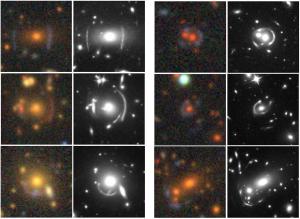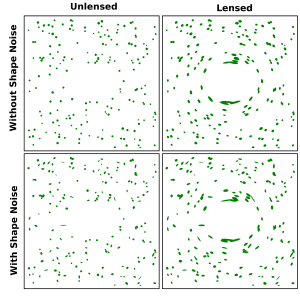Blog
A New Lens
on the Universe
20 May 2020
 Hubble Space Telescope, Dark Energy Camera Legacy Survey
Hubble Space Telescope, Dark Energy Camera Legacy SurveyGeneral relativity tells us that everything, even light, is affected by the mass of an object. When a beam of light passes near a large mass, its path is deflected. This shift in the direction of light is known as gravitational lensing, and it was one of the first confirmed effects of Einstein’s theory.
In cosmology, there are two types of gravitational lensing, and both play an important role in understanding the evolution of the universe. The first is weak lensing, where light from a distant galaxy passes through a cluster of galaxies, but not close to any particular galaxy. The bending of light is small, which means the shape of the galaxy is distorted slightly. By looking at these distortions, astronomers can measure the average density of matter in the universe. This helps us understand dark energy.
 Wikipedia
WikipediaThe second type is strong lensing, and it is rarer. For strong lensing, a distant galaxy has to be nearly blocked by a closer one. In this case, the light of the distant galaxy is strongly distorted, often into arcs of light surrounding the closer galaxy. Since the amount of distortion depends on the mass of the closer galaxy, it lets us measure the amount of dark matter in the galaxy. It also allows us to measure the expansion rate of the universe.
But because strongly lensed galaxies are rare, it has been difficult to find enough lensed galaxies for a good survey. To put good constraints on the measure of dark matter and dark energy, we need many more strongly lensed galaxies to study. Fortunately, we’re starting to find them.
Recently a team used an AI program to find lensed galaxies in sky survey data.1 After training the program on known lensed and unlensed galaxies, it then combed through observations to find more than 300 candidates lensed galaxies. Many of them were then confirmed by follow-up observations with the Hubble Space Telescope.
Now that the method has proved useful, the team plans to analyze other sky-survey data, with the goal of finding at least a thousand strongly lensed galaxies. If they are successful, the work will become a powerful tool for understanding the cosmos.
Huang, X., et al. “Finding Strong Gravitational Lenses in the DESI DECam Legacy Survey.” The Astrophysical Journal 894.1 (2020): 78. ↩︎